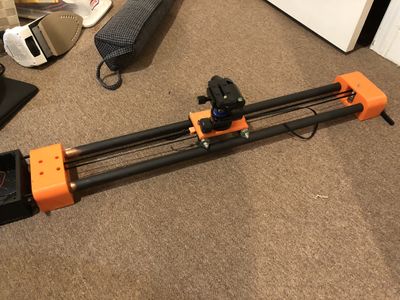Open Source Camera Slider
Project developed by MarkHansen (talk) 06:58, 12 December 2019 (UTC)
Abstract
This camera slider is designed to give the user the ability to make astrophotography time-lapses like those used in national geographic. Time-lapse sliders usually cost over $1000.00 dollars online even though they are very simple to make.
My slider is designed with a majority of 3D printed parts, Conduit Tubing, Electronics, and a stepper motor.
Alternatives can be found here $400.00 [1]
Expensive version $1000.00

| Nat Geo Timelapse |
|---|
Error in widget YouTube: Unable to load template 'wiki:YouTube' |
Bill of Materials
- Full BOM -- Materials needed for fabrication of device and alternative materials
- open source CAD files and STLs found here [2]
- PLA
- Glue (if desired)
- Small stepper motor $11.00[3]
- electrical wire $1.46[4]
- Battery holder (if desired) $2.21[5]
- Copper Conduit $3.00 from local hardware store
- Raspberry Pi or Arduino Mega $45.00 [6]
- Motor Controller $1.66 [7]
- On off switch $3.00 [8]
- Belt for driving [9]
- Bearings $10.00 [10]
- Various nuts and bolts found at hardware store.
All open source CAD and STL files for 3D printing can be found here [11].
Tools needed for fabrication of the OSAT
- MOST Delta RepRap or similar RepRap 3-D printer
- PLA filament
- some sort of glue to glue components together (if desired)
- Battery for Raspberry Pi and for motor
- Soldering Iron Kit
Skills and Knowledge Necessary to Make the OSAT
The design of this aquaponics system is easy to setup, but for more knowledge on how these types of systems work here are two links to a good article and video on how they work.
Common Problems and Solutions
- Make sure that the puzzle pieces fit together properly
- Make sure that holes for water align properly so that it can flow from one block to another
Cost savings
- For all parts of this build it totals roughly $60.00. You could buy an Arduino and potentially get the cost down to $30.00
- Cost savings for the project is about $340.00 ~85-92.5%
References
I used this persons site as a place to start [12].They did not make the code open source, so I have to write my own which is in progress.